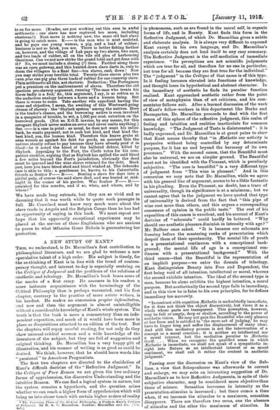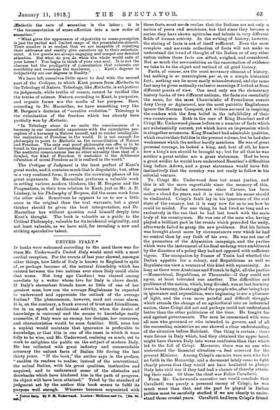A NEW STUDY OF KANT.*
-THIS, we understand, is Dr. Macmillan's first contribution to philosophical literature, and we are glad to welcome a new speculative talent of a high order. His subject is timely, for the re-thinking of Kant is in line with the trend of contem- Tbnuy thought, and interest to-day is especially centring on the Critique of Judgment and the problems of the relations of :aesthetic and teleology. Dr. Macmillan's book bears some of the marks of a first essay. He assumes in his readers a -more intimate acquaintance with the terminology of the -Critical Philosophy than is perhaps warranted, and his first chapter, contrary to the practice of more astute writers, is -hie hardest. He makes no concession propter infirmitatem, rand now and --then the -argument is almost unintelligible -Without a considerable knowledge of Kant's whole system. The truth is that the book is more - a commentary than an inde- pendent exposition, and Muck of it would have been more in place as disquisitions attached to an edition of the text. But the chapters will repay careful reading, for not only do they :show unusual critical acumen and a wide knowledge of the literature of the subject, but they are full of suggestive and -original thinking. Dr. Macmillan has a very happy gift of illustration,-and his manner of writing is as good as could be -desired. We think, however, that be should leave words like " passional " to American Pragmatists.
• The- first two chaptera are- directed to the elucidation of Xant's difficult doctrine of the "Reflective Judgment." In the Critique of Pure Beason we are given the two ordinary forms of apprehension, the discursive Understanding and the intuitive Reason: We can find a logical system in nature, but the system remains a hypothesis, and the question arises whether we can reach a higher form of apprehension which Will bring us into closer touch with certain higher orders of reality * The Cronning Phase of the Critical Philosophy: a Study in rant'* Critivte of Juilgracut. By R. A. C. Macmillan. Loudon: Macmillan and. Co. [los. net.) in phenomena, such as are found in the moral self, in organic forma of life, and in Beauty. Kant finds this form in the
Reflective Judgment, of which Dr. Macmillan gives a subtle and elaborate analysis. It is always very difficult to expound Kant except in his own language, and Dr. Macmillan's analysis certainly does not lend itself to any easy summary. The Reflective Judgment is the self-mediation of immediate experience. "Its perceptions are not scientific judgments which are true for ail, and therefore for no one in particular,
but true for all because they are first true for the individual." The "judgment" in the Critique of that name is of this type. In it feeling becomes elevated into functions of knowledge, and thought loses its hypothetical and abstract character. In the immediacy of aesthetic he finds its peculiar function realized. Kant approached aesthetic rather from the point of view of metaphysics than of art criticism, and his com-
mentator follows suit. After a learned discussion of the work of Kant's fellow-workers in this department like Burke and Baumgarten, Dr. Macmillan proceeds to deal with the first canon of this sphere of the reflective judgment, this realm of feeling and intuition and realities inarticulate for common knowledge. "The Judgment of Taste is disinterested" : it is badly expressed, and Dr. Macmillan is at great pains to show that Kant means thereby that "in _Esthetic our activity is
purposive without being controlled by any determinate purpose, for it has no end' beyond the harmony of its own processes." With the second canon, that the Beautiful must also be universal, we are on simpler ground. The Beautiful must not be identified with the Pleasant, which is peculiarly subjective. "The rose is beautiful" is a very different type of judgment from "This wine is pleasant." And in this connexion we may note that Dr. Macmillan, while we agree
with his general line of argument, seems to be a little fantastic in his pleading. Even the Pleasant, no doubt, has a trace of universality, though its significance is at a minimum ; but we cannot agree that in the judgment we have quoted that type of universality is derived from the fact that "this pipe of wine cost more than others, and this argues a corresponding consensus of opinion in the public taste." The rest of his exposition of this canon is excellent, and his account of Kant's doctrine of " schemata " could hardly be bettered. " Why should our aesthetic pleasure diminish in intensity with age?"
Mr. Balfour once asked. "It is because our schemata are freezing before the mustering ranks of presentation which despoil them of their spontaneity. The mental life of youth is a presentational continuum with a conceptional back- ground; the mental life of age is a conceptional con- tinuum with a presentational background." With the third canon—that the Beautiful is the representation of an implicit purpose—we enter the domain of teleology.
Kant distinguishes Beauty into Free and Dependent, the first being void of all intention, intellectual or moral, whereas the second exhibits intention. The ideal of the second type is man, because he alone exhibits the highest intention, a moral purpose. But aesthetically the second type fails in immediacy, and in this view he is false to his own principles, for he defines immediacy too narrowly.
"In contrast with cognition Esthetic is undoubtedly immediate, for it does not think the object discursively, but views it as a Whole whose parts are transparent. This perception, however, may be full or empty, deep or shallow, according to the power of aesthetic vision. He may not gain the Beautiful who only glances at her form and is satisfied in the mere art of judging, he may have to linger long and suffer the displacement of many ideas. And still this mediatory process is not the intervention of a concept or a moral reaction ; it is neither an intellectual nor a moral interest, but the mediation peculiar to Esthetic itself. • . When we recognize the qualified sense in which Esthetic is immediate, we shall not speak of a sympathetic in- sight into Nature as an intellectual interest or as moral sentiment, we shall call it rather the content in aesthetic judgment."
Passing over the discussion on Kant's view of the Sub- lime, a view that Schopenhauer was afterwards to correct and enlarge, we may note an interesting suggestion of Dr. Macmillan's as to how Reflective Judgments, in spite of their subjective character, may be considered more objective than those of science. Sensation increases in intensity as the presentation-stimulus is increased ; but there comes a time when, if we increase the stimulus to a maximum, sensation disappears. There are therefore two zeros, one the absence of stimulus and the other the maximum' of stimulus. In
eraithetic the zero of eensation is the latter ; it is "the transmutation of sense-affeetion into a new order of sensation."
"What gives the appearance of objectivity to sense-perception is just the partial and limited range of the presentation-stimuli. Their number is so modest that we are incapable of rejecting their addresses and readily give ourselves up to their entertain- ment. A few guests are always engaging and compel our devoted attention. Bat what do you do- when the whole world calla at your house ? You begin to think of your own gold. It is not the absence but the prodigality of presentation that exhausts our sensibility and oversteps the maximum.. . . Kant's degrees in Subjectivity are our degrees in Reality."
We have left ourselves little space to deal with the second part of the Critique, in which Kant passes from .ZEsthetic to the Teleology of Nature. Teleology, like „Esthetic, is subjective;
its judgments, while truths of reason, cannot be verified like the truths of science. Nature, according to Kant, is purposive, and organic forms are the• media of her purpose. Here, according to Dr. Macmillan, we have something very like If. Bergson's doctrine of "creative evolution." Teleology is the culmination of the freedom which has already been partially won by ../Esthetic.
"In Teleology alone do we unite the consciousness of a harmony in our immediate experience with the cumulative per- ception of a harmony in Nature herself, and so render intelligible the realization of Freedom in the world. It is not enough for philosophy to point to /esthetic as the reconciliation of Nature and Freedom. The only real proof philosophy can offer is to be found in the process of interpreting Nature, and that is Teleology. The aesthetic consciousness has no other actuality than that of a Symbol, the kind of Freedom it embodies is the deliberate refutation of moral Freedom as it is realized in the world."
The Critique of Judgment is the least perfect of Kant's great works, audit contains much that is disputable; but, often in a very confused berm, it reveals the crowning phases of his great arguments. Dr. Macmillan performs a valuable work in setting various modern thinkers, like M. Bergson and the Pragmatists, in their true relation to Kant, just as Mr. A. D. Lindsay, in his Philosophy of Bergson, did the same work from the other side. Sometimes he appears to us to see a little more in the original than the text warrants, but a great thinker should be given the best interpretation, and Dr.
Macmillan has without question read himself deeply into Kant's thought. The book is valuable as a guide to the Critical Philosophy, valuable for its incidental originality, and not least valuable, as we have said, far revealing a new and striking speculative talent.











































 Previous page
Previous page